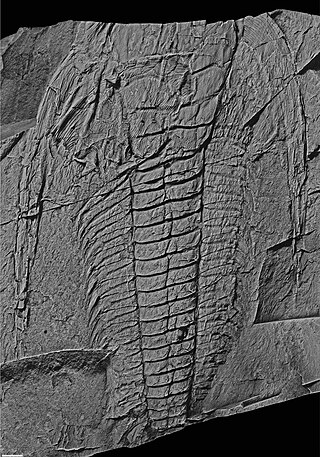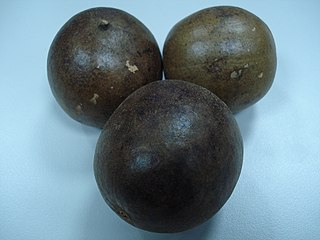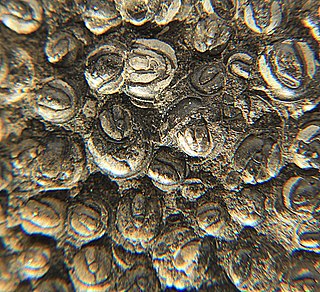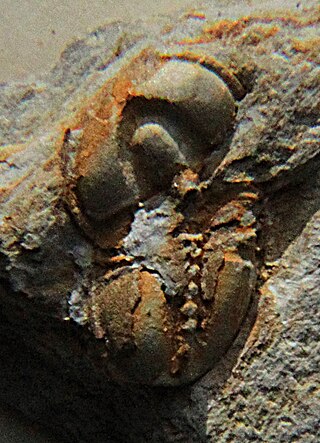
John William Salter was an English naturalist, geologist, and palaeontologist.

Caridina is a genus of freshwater atyid shrimp. They are widely found in tropical or subtropical water in Asia, Oceania and Africa. They are filter-feeders and omnivorous scavengers. They range from 0.9 to 9.8 mm to 1.2–7.4 mm in carapace length.

The Furongian is the fourth and final epoch and series of the Cambrian. It lasted from 497 to 485.4 million years ago. It succeeds the Miaolingian series of the Cambrian and precedes the Lower Ordovician Tremadocian Stage. It is subdivided into three stages: the Paibian, Jiangshanian and the unnamed 10th stage of the Cambrian.
Harry Blackmore Whittington FRS was a British palaeontologist who made a major contribution to the study of fossils of the Burgess Shale and other Cambrian fauna. His works are largely responsible for the concept of Cambrian explosion, whereby modern animal body plans are explained to originate during a short span of geological period. With initial work on trilobites, his discoveries revealed that these arthropods were the most diversified of all invertebrates during the Cambrian Period. He was responsible for setting the standard for naming and describing the delicate fossils preserved in Konservat-Lagerstätten.

Siraitia grosvenorii, also known as monk fruit, monkfruit, luó hàn guǒ, or Swingle fruit, is a herbaceous perennial vine of the gourd family, Cucurbitaceae. It is native to southern China. The plant is cultivated for its fruit extract containing mogrosides. Mogroside extract has been used as a low-calorie sweetener for drinks and in traditional Chinese medicine. One mogroside, mogroside V, creates a sweetness sensation 250 times stronger than sucrose.

Agnostus is a genus of agnostid trilobites, belonging to the family Agnostidae, that lived during the late Middle Cambrian – early Upper Cambrian. It is the type genus of the family Agnostidae and is subdivided into two subgenera, Agnostus and Homagnostus.
The Kaili Formation is a stratigraphic formation which was deposited during the Lower and Middle Cambrian. The formation is approximately 200 metres (660 ft) thick and was named after the city Kaili in the Guizhou province of southwest China.

Meteoraspis is an extinct genus of ptychopariid trilobites of the family Tricrepicephalidae. The various species lived from 501 to 497 million years ago during the Dresbachian faunal stage of the late Cambrian Period. Fossils of Meteoraspis are characteristic of Late Cambrian strata in North America, though they are found in Late Cambrian strata elsewhere in the world, such as M. nevensis from Victoria Land, Antarctica.

Xystridura Whitehouse, 1936 is a genus of Redlichiid trilobite described originally from the Middle Cambrian (Miaolingian) strata of Queensland, Australia. The genus ranges upwards from Ordian into Florian Stages in terms of Australian Cambrian stratigraphic nomenclature.

Peronopsis is a genus of trilobite restricted to the Middle Cambrian. Its remains have been found in Asia, Australia, Europe, and North America.

Tuzoia is an extinct genus of large bivalved arthropod known from Early to Middle Cambrian marine environments from what is now North America, Australia, China, Europe and Siberia. The large, domed carapace reached lengths of 180 millimetres (7.1 in), making them amongst the largest known Cambrian arthropods.

Pagetia is a genus of small trilobite, assigned to the Eodiscinid family Pagetiidae and which had global distribution during the Middle Cambrian. The genus contains 55 currently recognized species, each with limited spatial and temporal ranges.
Acmarhachis is a genus of trilobites in the order Agnostida, which lived in what are now Australia, Canada, China (Anhui), Kazakhstan, Russia (Kharaulakh), and the US. It was described by Resser in 1938, and the type species is Acmarhachis typicalis.

Eodiscina is trilobite suborder. The Eodiscina first developed near the end of the Lower Cambrian period and became extinct at the end of the Middle Cambrian. Species are tiny to small, and have a thorax of two or three segments. Eodiscina includes six families classified under one superfamily, Eodiscoidea.

Pentagnostus is a genus of trilobites restricted to the Middle Cambrian. Its remains have been found in Siberia, Australia, North America, Scandinavia, and Kazakhstan.

The Kinzers Formation is a geologic formation in Pennsylvania. It preserves fossils dating back to the Cambrian Period.

Serrodiscus Richter and Richter 1941. is a genus of Eodiscinid trilobite belonging to the family Weymouthiidae Kobayashi T. (1943), Order Agnostida. It lived during the late Lower Cambrian, with remains found in Canada, China (Gansu), The United Kingdom (England), Germany (Silesia), Poland, the Russian Federation, and the United States. It is named for the spines on the ventral side of the pygidium, which give it a serrated impression.
Christina Lochman-Balk was an American geologist who specialized in the study of Paleozoic era fossils, formerly known as Cambrian Paleontology. Lochman specifically dealt with Cambrian trilobites and invertebrates. During her career, it was not very common for women to pursue degrees or careers in geology, which was studied mostly by men. Along with her research, she also served as a lecturer and professor at the universities Mount Holyoke, University of Chicago and the New Mexico Institute of Mining and Technology. She received two degrees from Smith College in Northampton, Massachusetts in Geology, and her doctorate at Johns Hopkins University in 1933. She married Robert Balk in 1947, who was a geology professor at the University of Chicago. Following her husband's death in 1955, she became a full professor as well as appointed head of the geology department of the New Mexico Institute of Mining and Technology in 1957. She retired from her position in 1972.

Bailiaspis Resser, 1936, is a Middle Cambrian (Miaolingian) trilobite genus belonging to the Family Conocoryphidae Angelin, 1854. Within the Acado-Baltic region, the genus ranges from Wuliuan into Guzhangian age strata.














